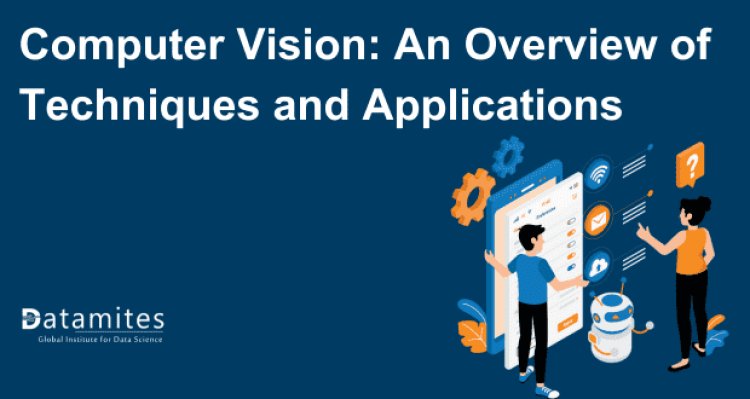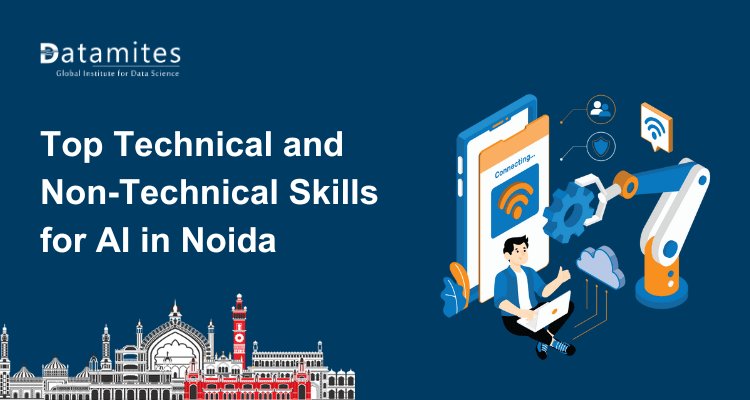Computer Vision: An Overview of Techniques and Applications
Computer vision enables machines to interpret and understand visual data, using techniques like image processing and deep learning. This blog explores its key methods and diverse applications across industries.

Computer vision, a fascinating branch of artificial intelligence, is transforming our world in ways we once considered impossible. From the smartphones in our pockets to the cutting-edge technologies in autonomous vehicles, computer vision is everywhere. What is computer vision, and why is it so important? In simple terms, computer vision enables machines to see and interpret the visual world, much like humans do. Its significance spans various industries, enhancing productivity, improving safety, and creating new opportunities.
In this blog post, we’ll explore the fascinating world of computer vision in depth. We'll explore its key techniques, understand how it works, and discover its many real-world applications. Whether you're pursuing an Artificial Intelligence course or simply curious about the field, this overview will provide valuable insights into the remarkable world of computer vision.
Understanding Computer Vision
Computer vision has made significant progress since it first emerged. The field first emerged in the 1960s when researchers began exploring ways to make machines interpret visual data. Early milestones include the development of simple image processing algorithms and the first experiments in pattern recognition. However, it wasn't until the rise of machine learning in the 1990s that computer vision truly began to flourish. Today, powered by deep learning, computer vision has reached unprecedented levels of accuracy and capability.
How It Works: The Mechanics Behind the Magic
At its core, computer vision involves processing and analyzing digital images to extract meaningful information. This process typically involves three main steps: image processing, feature extraction, and pattern recognition. Image processing enhances the quality of the image, making it easier to analyze. Feature extraction identifies important elements within the image, such as edges, corners, and textures. Finally, pattern recognition uses algorithms to identify and categorize objects or patterns within the image. Together, these steps enable machines to "see" and understand the visual world.
Key Concepts: Pixels, Features, and More
Understanding computer vision requires familiarity with a few essential concepts.
- Pixels: The smallest unit of an image, representing a single point of color.
- Image Representation: The way images are stored and processed by computers, often as a grid of pixels.
- Features: Distinctive elements of an image, such as edges, shapes, or textures, that help in identifying objects.
These concepts form the foundation of computer vision and are crucial for the techniques and applications we'll explore next.
Refer these articles:
- Why Artificial Intelligence Career in 2024
- AI Ethics: Navigating the Ethical Challenges of AI Development
- Introduction to Neural Networks: Building Blocks of AI
Core Techniques in Computer Vision: The Building Blocks of Vision
Computer vision is a fascinating field that combines computer science, artificial intelligence and machine learning to enable machines to interpret and understand visual information from the world. Here are some core techniques that serve as the building blocks of computer vision:
Image Processing: Enhancing the Visual Data
Image processing is a critical step in computer vision, as it involves improving the quality of images to make them more suitable for analysis. Techniques like filtering, edge detection, and histogram equalization are commonly used to enhance images.
- Filtering: Removes noise from the image, making it clearer.
- Edge Detection: Identifies the boundaries within an image, which is essential for object recognition.
- Histogram Equalization: Adjusts the contrast of the image, improving its visibility.
These techniques are fundamental in preparing images for further analysis, ensuring that the data extracted is accurate and reliable.
Feature Extraction: Identifying the Key Elements
Once an image is processed, the next step is to extract features. Features are distinctive elements within an image that help in identifying objects. Common methods for feature extraction include SIFT (Scale-Invariant Feature Transform), SURF (Speeded-Up Robust Features), and ORB (Oriented FAST and Rotated BRIEF).
- SIFT : Identifies and characterizes local features within images, making it effective for object recognition.
- SURF: A faster alternative to SIFT, focusing on efficiency without sacrificing accuracy.
- ORB: Combines speed and accuracy, making it ideal for real-time applications.
These methods are essential for enabling machines to recognize and interpret objects within images.
Object Detection: Recognizing What's in the Image
Object detection is a crucial technique in computer vision that involves identifying and locating objects within an image. Popular algorithms used for object detection include YOLO (You Only Look Once), SSD (Single Shot Multibox Detector), and R-CNN (Region-Based Convolutional Neural Networks).
- YOLO: A real-time object detection system that processes images quickly and accurately.
- SSD: Balances speed and accuracy, making it suitable for various applications.
- R-CNN: Focuses on high accuracy by using regions of interest within the image.
These algorithms have revolutionized fields like autonomous vehicles, security, and healthcare by enabling machines to detect and recognize objects with high precision.
Image Segmentation: Breaking Down the Image
Image segmentation is the process of dividing an image into segments, making it easier to analyze. This technique is essential in applications where precise analysis of specific regions within an image is required. Common segmentation techniques include thresholding, clustering, and deep learning-based methods.
- Thresholding: Simplifies the image by converting it to binary form, making it easier to segment.
- Clustering: Groups similar pixels together, identifying distinct regions within the image.
- Deep Learning-Based Methods: Use neural networks to achieve highly accurate segmentation.
Image segmentation plays a vital role in medical imaging, autonomous vehicles, and more, where detailed analysis is crucial.
Pattern Recognition: Finding the Patterns in Data
Pattern recognition involves identifying patterns within data, which is essential for tasks like image classification and object recognition. There are several approaches to pattern recognition, including template matching and machine learning-based classifiers.
- Template Matching: Compares portions of the image to predefined templates to identify objects.
- Machine Learning-Based Classifiers: Use algorithms to learn patterns from data and make predictions.
Pattern recognition is a fundamental technique in computer vision, enabling machines to classify and recognize objects accurately.
Deep Learning in Computer Vision: The Game Changer
Deep learning has revolutionized computer vision by enabling machines to learn and improve from data without explicit programming. Key models in deep learning include Convolutional Neural Networks (CNNs), Recurrent Neural Networks (RNNs), and Generative Adversarial Networks (GANs).
- CNNs: Excel at processing and analyzing images, making them ideal for tasks like image classification and object detection.
- RNNs: Handle sequential data, such as video frames, allowing for temporal analysis.
- GANs: Generate realistic images by pitting two neural networks against each other, creating high-quality visuals.
Deep learning has pushed the boundaries of computer vision, leading to breakthroughs in fields like healthcare, entertainment, and autonomous systems.
Refer these articles:
- What Is AI Engineer Course
- What is Datamites Certified Data Analyst Certification
- What is Certified Data Scientist Course
Real-World Applications of Computer Vision: Transforming Industries
Computer vision, a field of artificial intelligence that enables machines to interpret and make decisions based on visual input, has a wide range of real-world applications that are transforming various industries. Here are some key examples:
Healthcare: Revolutionizing Medical Imaging
Computer vision is transforming healthcare by enabling more accurate and efficient diagnostics. Medical imaging techniques like MRI analysis and tumor detection rely heavily on computer vision to identify abnormalities.
- MRI Analysis: Detects and analyzes complex patterns in medical images, aiding in diagnosis.
- Tumor Detection: Identifies cancerous tissues with high accuracy, improving treatment outcomes.
By enhancing the accuracy of medical imaging, computer vision is helping save lives and improve patient care.
Autonomous Vehicles: Powering Self-Driving Cars
Self-driving cars rely on computer vision to perceive their surroundings and make decisions in real time. This technology is at the heart of autonomous vehicles' perception systems, allowing them to detect obstacles, recognize traffic signs, and navigate complex environments.
- Obstacle Detection: Identifies and avoids obstacles on the road, ensuring safe navigation.
- Traffic Sign Recognition: Recognizes and interprets traffic signs, enabling the vehicle to follow road rules.
As autonomous vehicles become more prevalent, computer vision will play a crucial role in ensuring their safety and reliability.
Retail and E-Commerce: Enhancing Shopping Experiences
In the retail and e-commerce industries, computer vision is enhancing the shopping experience through applications like visual search and automated inventory management.
- Visual Search: Allows customers to search for products using images, making shopping more intuitive.
- Automated Inventory Management: Tracks stock levels in real-time, reducing the need for manual inventory checks.
These applications are improving efficiency and convenience for both retailers and consumers.
Security and Surveillance: Keeping an Eye on Safety
Computer vision is widely used in security and surveillance to enhance safety and monitor environments. Facial recognition and anomaly detection are two key applications in this field.
- Facial Recognition: Identifies individuals in real-time, enhancing security in public spaces.
- Anomaly Detection: Monitors for unusual activities, alerting authorities to potential threats.
These technologies are making our world safer by enabling more effective monitoring and response to security threats.
Agriculture: Driving Precision Farming
In agriculture, computer vision is driving precision farming by enabling better crop monitoring, disease detection, and yield estimation.
- Crop Monitoring: Analyzes plant health and growth, optimizing farming practices.
- Disease Detection: Identifies diseases early, preventing crop loss and ensuring food security.
Computer vision is helping farmers make data-driven decisions, improving productivity and sustainability.
Entertainment and Media: Creating Immersive Experiences
The entertainment and media industries are leveraging computer vision to create immersive experiences through augmented reality (AR), virtual reality (VR), and visual effects.
- AR/VR: Enhances user experiences by integrating virtual elements into the real world.
- Visual Effects: Creates realistic and engaging digital content, transforming the entertainment landscape.
These applications are pushing the boundaries of creativity and innovation, delivering new ways for audiences to experience content.
Refer these articles:
- Artificial Intelligence Course Fee in India
- Artificial Intelligence Course Fee in Bangalore
- Artificial Intelligence Course Fee in Pune
Future Directions in Computer Vision: What's Next?
Computer vision is a rapidly evolving field with several exciting directions for the future. Here are some crucial areas to keep an eye on:
Emerging Techniques: The Next Frontier
As computer vision continues to evolve, emerging techniques like self-supervised and unsupervised learning are gaining traction. These methods allow machines to learn from unlabelled data, reducing the need for extensive human intervention.
- Self-Supervised Learning: Leverages data's inherent structure to guide learning, reducing the need for labeled data.
- Unsupervised Learning: Extracts patterns and features from data without explicit labels, offering new possibilities for discovery.
These techniques have the potential to further advance computer vision, making it more efficient and accessible.
Integration with Other Technologies: IoT and Edge Computing
Computer vision is increasingly being integrated with other technologies like the Internet of Things (IoT) and edge computing. This integration enables real-time processing and analysis, making computer vision applications more responsive and scalable.
- IoT Integration: Connects devices to the cloud, enabling remote monitoring and control.
- Edge Computing: Handles data processing locally, which decreases latency and enhances performance.
These advancements are expanding the reach of computer vision, bringing its benefits to more industries and applications.
Ethical AI Development: Navigating Challenges
As computer vision technology progresses, ethical considerations are becoming more critical. Efforts are underway to develop regulations and guidelines that ensure the responsible deployment of computer vision technologies.
- Regulations: Establish frameworks to govern the use of computer vision, ensuring privacy and security.
- Guidelines: Provide best practices for developing and deploying ethical AI systems.
By addressing these challenges, the industry can ensure that computer vision is used in ways that benefit society while minimizing risks.
Computer vision is transforming industries and everyday life with its ability to analyze and interpret visual data. From healthcare to agriculture, its applications are vast and varied. As this technology continues to evolve, its potential will only grow. Whether you're taking an Artificial Intelligence training course or exploring its applications, now is the time to dive into the world of computer vision. The future is bright, and it's visual.
At DataMites Institute, we are at the forefront of AI education, dedicated to empowering professionals with cutting-edge knowledge and skills. Our Artificial Intelligence course, accredited by both IABAC and NASSCOM FutureSKills, is meticulously designed to provide comprehensive insights into AI technologies and applications. We offer a specialized Artificial Intelligence for Managers program, tailored to equip leaders with the strategic understanding needed to drive AI initiatives within their organizations. Join us to harness the power of Artificial Intelligence, gain industry-recognized credentials, and stay ahead in the evolving digital landscape. DataMites is your gateway to mastering Artificial Intelligence and transforming your career.
DataMites offers a globally recognized Artificial Intelligence course, providing industry-standard certification. On par with esteemed institutions like IIT and IIM, DataMites delivers high-quality AI training. The program covers advanced AI concepts, practical projects, and expert guidance, ensuring professionals gain the skills needed to thrive in AI-driven fields.





